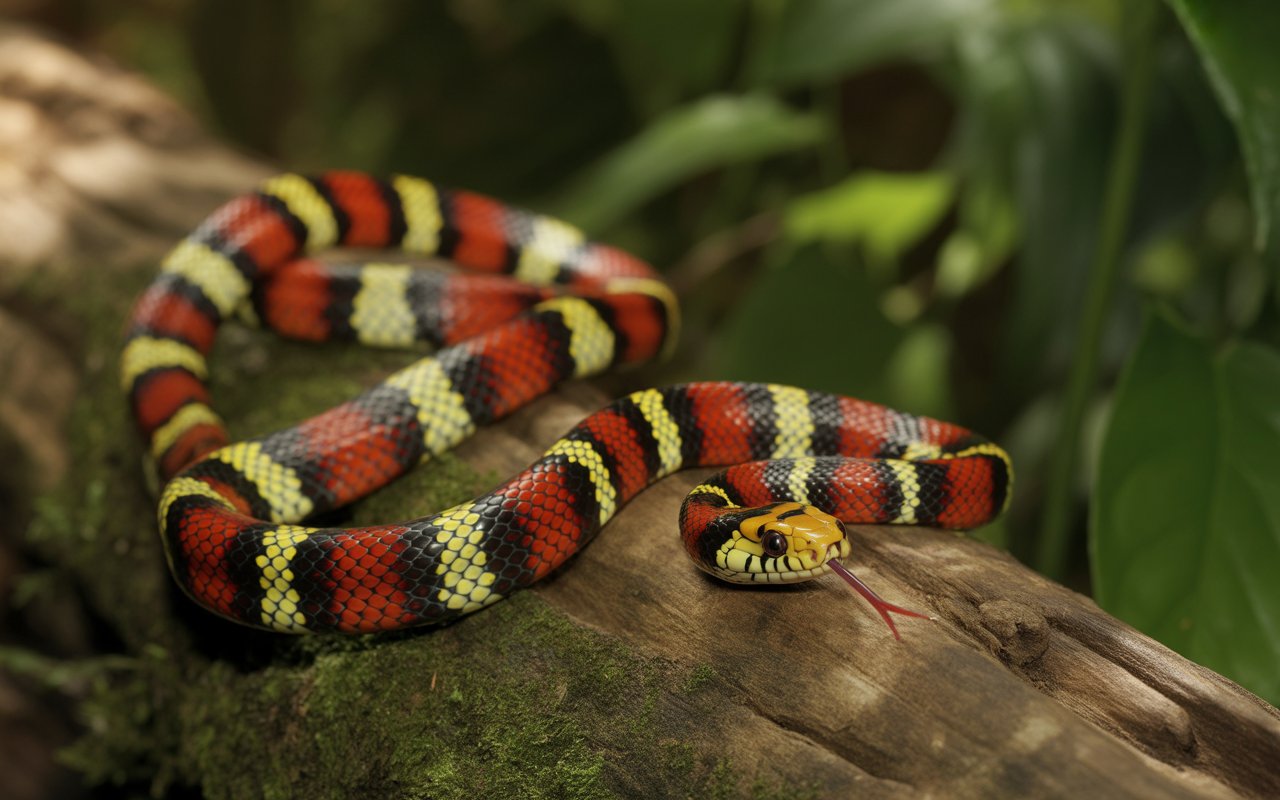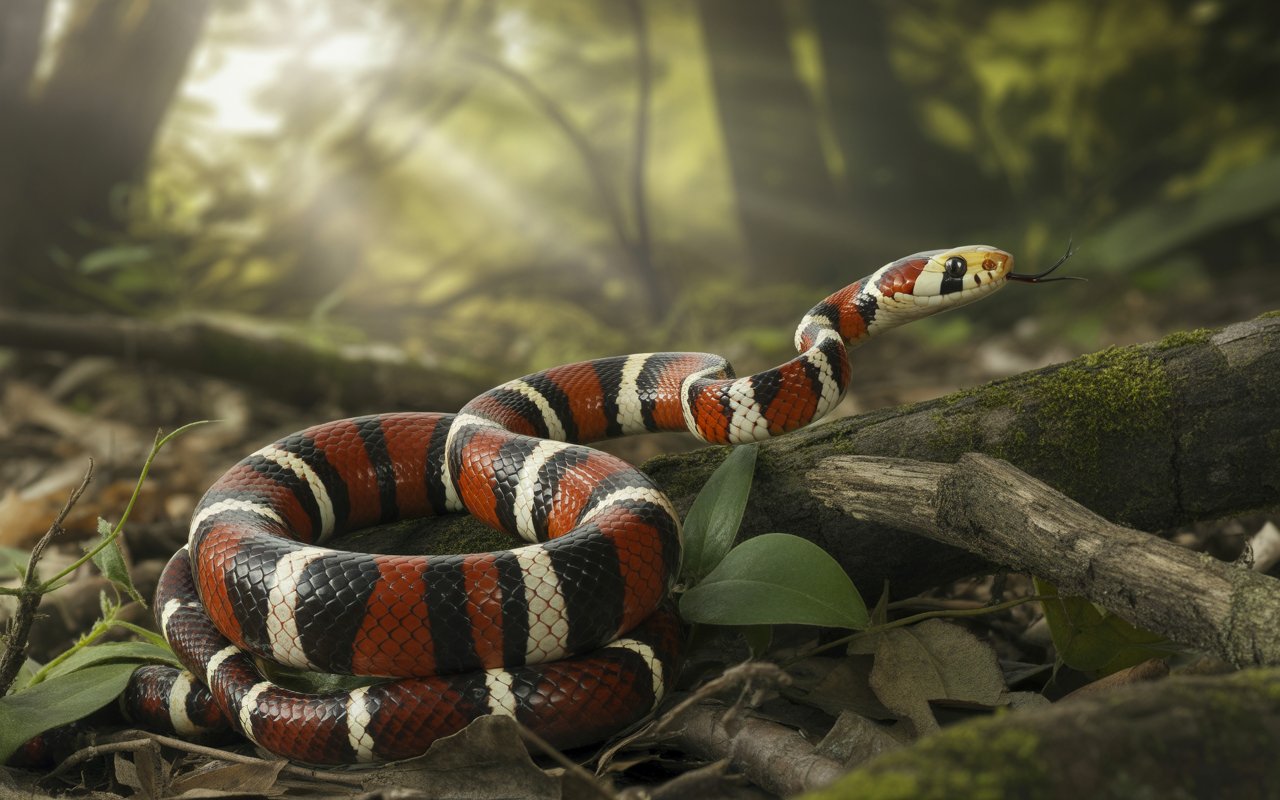When it comes to the world of reptiles, few creatures capture curiosity quite like the milk snake. With its bright, eye-catching bands of red, black, and yellow (or white), this harmless serpent often sparks alarm among those who mistake it for a venomous coral snake. Yet behind this confusion lies one of nature’s most brilliant disguises—and a story worth exploring.
In this article, we’ll take a journey through the vibrant world of milk snakes: their habitats, diet, behavior, and unique adaptations. We’ll also uncover some fascinating myths, explore their role in ecosystems, and even touch on how to care for them as pets. By the end, you might find yourself admiring this misunderstood reptile rather than fearing it.
What Exactly Is a Milk Snake?
A milk snake is a nonvenomous species belonging to the Lampropeltis triangulum complex. The name “Lampropeltis” comes from Greek words meaning “shiny shield,” a nod to the glossy, smooth scales that make the milk snake so visually striking.
Milk snakes are part of the kingsnake family and are famous for their resemblance to venomous coral snakes—a resemblance so uncanny that it’s often summarized by the rhyme:
“Red meets black, you’re safe to track; red meets yellow, beware that fellow.”
This clever rhyme helps people distinguish between the harmless milk snake (red touches black) and the deadly coral snake (red touches yellow).
The Origin of the Name “Milk Snake”
So, why “milk snake”? This unusual name traces back to an old rural legend. Farmers once believed that these snakes would sneak into barns and drink milk straight from cows’ udders at night. In reality, milk snakes were simply hunting rodents hiding in the barns.
Since snakes can’t digest lactose, the idea of one “milking” a cow is biologically impossible—but the name stuck!
Physical Appearance: Nature’s Masterpiece in Scales

Milk snakes are among the most visually stunning reptiles in North America. Their color patterns vary widely depending on the region, but most display alternating bands of red, black, and either yellow or white. These patterns act as mimicry, a survival strategy that helps them ward off predators by resembling venomous species.
-
Size: Adults typically range from 2 to 4 feet in length, though some can grow larger.
-
Shape: They have slender bodies with smooth, glossy scales.
-
Color Variation: Western varieties may have more muted tones, while eastern ones boast brighter, coral-like bands.
If you were to compare a milk snake to a work of art, it would be like a living abstract painting—each scale carefully painted to perfection.
Where Do Milk Snakes Live?
Milk snakes have an impressively wide range. They’re found across North and Central America, from southern Canada all the way down to northern South America. They adapt easily to different environments, including:
-
Forests and woodlands
-
Rocky hillsides
-
Grasslands
-
Farmlands and barns
-
Suburban areas
Their adaptability helps them survive in both dry and humid climates. During the day, milk snakes hide under logs, rocks, or leaf litter to stay cool and safe from predators. At night, they emerge to hunt—making them nocturnal hunters.
What Do Milk Snakes Eat?
When it comes to diet, milk snakes are opportunistic eaters. They’re carnivorous, feeding mainly on:
-
Mice and small rodents
-
Lizards
-
Frogs
-
Small birds and eggs
-
Other snakes (yes, even venomous ones!)
Their appetite for rodents makes them valuable allies to farmers and gardeners. In fact, they play a vital ecological role in controlling pest populations.
Milk snakes kill their prey through constriction—wrapping their muscular bodies around the animal until it suffocates, then swallowing it whole.
Behavior and Temperament: Shy but Brave

Despite their intimidating appearance, milk snakes are gentle and non-aggressive creatures. When threatened, they don’t bite unless provoked. Instead, they rely on defensive tactics such as:
-
Vibrating their tails (mimicking rattlesnakes)
-
Releasing a musky odor to deter predators
-
Flattening their bodies to appear larger
These tricks, along with their mimicry, help them stay safe in a world where many animals prefer to avoid snakes altogether.
Milk Snake vs. Coral Snake: Spot the Difference
One of the most common questions people ask is how to tell the difference between a milk snake and a coral snake. Here’s a quick breakdown:
| Feature | Milk Snake | Coral Snake |
|---|---|---|
| Color Pattern | Red touches black | Red touches yellow |
| Head Shape | Rounded | Blunt and short |
| Pupil Type | Round | Round (but smaller) |
| Venomous? | No | Yes |
| Behavior | Shy, harmless | Secretive, venomous |
In short: when red touches black, it’s your harmless friend, the milk snake!
Reproduction and Life Cycle
Milk snakes breed during spring and early summer. After mating, the female lays 4 to 15 leathery eggs in a warm, hidden spot—often under logs or decaying vegetation.
After about 6 to 10 weeks, the hatchlings emerge. These baby snakes are independent from birth, hunting small insects and lizards right away.
-
Lifespan in the wild: Around 10 years
-
Lifespan in captivity: Up to 20 years
That’s right—milk snakes can live twice as long under human care, thanks to consistent food and protection.
Natural Predators and Defense Mechanisms

Like most snakes, milk snakes have their share of enemies. Their main predators include:
-
Hawks and owls
-
Foxes and raccoons
-
Larger snakes
To defend themselves, they rely on camouflage and mimicry. Their colorful bands trick predators into thinking they’re dangerous coral snakes. It’s a fascinating example of Batesian mimicry—where a harmless species imitates a harmful one to avoid being eaten.
The Milk Snake’s Role in the Ecosystem
Though small, milk snakes play a huge ecological role. By feeding on rodents, they help prevent overpopulation and reduce the spread of diseases carried by pests. They also serve as prey for larger animals, maintaining the balance of their ecosystems.
In a way, milk snakes are like the unseen custodians of nature—quietly keeping things in order without anyone noticing.
Milk Snakes as Pets: Gentle and Easy to Care For
Because of their docile temperament and striking beauty, milk snakes have become popular in the pet trade. For beginners interested in reptile keeping, they make an excellent choice.
Here’s what potential owners should know:
-
Tank Size: A 20-gallon tank is sufficient for one adult.
-
Temperature: Maintain a gradient between 75°F and 85°F.
-
Humidity: Moderate humidity (40–60%) is ideal.
-
Diet: Feed appropriately sized frozen-thawed mice every 1–2 weeks.
-
Handling: Gentle handling helps them stay tame.
They’re low-maintenance, hardy, and rarely bite—perfect for those new to snake keeping.
Myths and Misunderstandings
Few animals have been surrounded by as many myths as the milk snake. Let’s debunk some of the most common ones:
-
Myth 1: They drink milk from cows.
-
Truth: Completely false. They hunt rodents in barns, not milk cows.
-
-
Myth 2: They’re venomous.
-
Truth: Milk snakes are harmless and pose no danger to humans.
-
-
Myth 3: They attack people.
-
Truth: They’re shy creatures that prefer to flee rather than fight.
-
These misconceptions have led to unnecessary fear, but education can help people see them for the gentle creatures they are.
Subspecies: A Rainbow of Variations
There are over 20 recognized subspecies of milk snakes, each adapted to its region with distinct colors and patterns. Some of the most notable include:
-
Eastern Milk Snake (L. t. triangulum) – Found in the northeastern U.S., grayish background with red blotches.
-
Pueblan Milk Snake (L. t. campbelli) – Bright red, black, and white bands; popular as a pet.
-
Honduran Milk Snake (L. t. hondurensis) – Larger and vividly colored, often bright red and orange.
-
Louisiana Milk Snake (L. t. amaura) – Distinct narrow white bands and dark red scales.
Each subspecies tells a story of adaptation and evolution, reflecting the diversity of habitats they thrive in.
Conservation Status: Are Milk Snakes Endangered?
The good news is that milk snakes are not endangered. They’re classified as “Least Concern” by the IUCN. However, certain local populations face threats from:
-
Habitat loss due to urban expansion
-
Road mortality
-
Human persecution (people mistaking them for venomous snakes)
Conservation efforts focus on educating the public and preserving natural habitats. The more people learn about them, the less likely they are to harm them out of fear.
Interesting Facts About Milk Snakes
Here are a few surprising tidbits that might make you appreciate milk snakes even more:
-
They can vibrate their tails rapidly, sounding like a rattlesnake when on dry leaves.
-
They’re excellent climbers, often found in trees or walls.
-
Their name “Lampropeltis” means “shiny shield,” a perfect description of their glossy scales.
-
Milk snakes are immune to certain snake venoms, allowing them to prey on other snakes safely.
-
They have been spotted as high as 8,000 feet in elevation!
Why Milk Snakes Matter
In a world where snakes are often misunderstood and feared, the milk snake stands as a symbol of misjudged beauty. It reminds us how easy it is to mistake appearance for danger—and how much nature relies on balance and perception.
Like a misunderstood artist, the milk snake’s vivid colors aren’t a warning of harm, but a masterpiece of survival. They play their part quietly, controlling pests, maintaining ecological harmony, and dazzling those who take a moment to look closer.
Conclusion
The milk snake is more than just a pretty face with striking colors. It’s a fascinating blend of adaptability, beauty, and ecological importance. By understanding its habits, habitat, and harmless nature, we can replace fear with respect.
So the next time you see a slender, banded snake slithering through the grass, take a breath before you scream—it might just be one of nature’s most brilliant mimics going about its quiet business.
FAQs About Milk Snakes
1. Are milk snakes venomous?
No, milk snakes are completely nonvenomous. They rely on mimicry to appear dangerous, but they pose no threat to humans.
2. How can you tell a milk snake from a coral snake?
Look at the color pattern: if red touches black, it’s a harmless milk snake. If red touches yellow, it’s a venomous coral snake.
3. What do milk snakes eat in the wild?
They primarily eat rodents, lizards, small birds, and even other snakes. Their diet helps control pest populations.
4. Can milk snakes be kept as pets?
Yes! They are docile, low-maintenance, and ideal for beginners. With proper care, they can live up to 20 years in captivity.
5. Why are milk snakes important to the ecosystem?
They help regulate populations of small mammals and act as prey for larger animals, keeping the ecosystem balanced and healthy.













